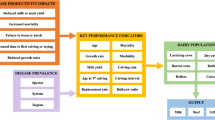Abstract
Anthrax is a fatal infectious disease which can affect animals and humans alike. Anthrax outbreaks occur periodically in animals, and they are of particular concern in herbivores, due to substantial economic consequences associated with animal death. The purpose of this study is to develop optimal control interventions that focus on vaccinating susceptible animals and/or removing infected carcasses. Our mathematical goal is to minimize the infectious animal population while reducing the cost of interventions. Optimal control interventions are derived theoretically, and numerical results with conclusions are presented.










Similar content being viewed by others
References
Ala’Aldeen D (2001) Risk of deliberately induced Anthrax outbreak. Lancet 358:1386–1388
Beyer W, Turnbull PCB (2009) Anthrax in animals. Mol Aspects Med 30:481–489
Bouzianas DG (2009) Medical countermeasures to protect humans from Anthrax bioterrorism. Trends Microbiol 17(11):522–528
CDC (2014) Report on the potential exposure to Anthrax. Technical Report 7/11, centers for disease control and prevention
Conger TH (2001) Anthrax epizootic texas, summer of 2001. In: Proceedings of the one hundred and fifth annual meeting, volume 207. United States Animal Health Association
D’Aamelio E (2015) Historical evolution of human Anthrax from occupational disease to potentially global threat as bioweapon. Environ Int 85:133–146
Dragon DC, Elkin BT (2001) An overview of early Anthrax outbreaks in Northern Canada: field reports of the health animal branch, Agriculture, Canada, 1962–1971. Artic 54:32–40
Fasanella A (2005) Molecular diversity of Bacillus anthracis in Italy. J Clin Microbiol 43:3398–3401
Fasanella A, Galante D, Garofolo G, Jones MH (2010) Anthrax undervalued zoonosis. Vet Microbiol 140:318–331
Fouet A (2002) Diversity among French Bacillus anthracis isolates. J Clin Microbiol 40:4732–4734
Friedman A, Yakubu A-A (2013) Anthrax epizootic and migration: persistence or extinction. Math Biosci 241(1):137–144
Furniss PR, Hahn BD (1981) A mathematical model of an Anthrax epizootic in the Kruger National Park. Appl Math Model 5(3):130–136
Grabenstein JD (2008) Countering Anthrax: vaccines and immunoglobulins. Clin Infect Dis 46:129–136
Hahn BD, Furniss PR (1983) A deterministic model of an Anthrax epizootic: threshold results. Ecol Model 20(2–3):233–241
Hart CA, Beeching NJ (2002) A spotlight on Anthrax. Clin Dermatol 20:365–375
Hugh-Jones M (1999) 1996–1997 Global Anthrax report. J Appl Microbiol 87:189–91
Hugh-Jones M, de Vos EV (2002) Anthrax and wildlife. Rev Sci Tech 2:359–389
Jackson PJ, Hugh-Jones ME, Adair DM (1998) PCR analysis of tissue samples from the 1979 Sverdlovsk Anthrax victims: the presence of multiple Bacillus anthracis strains in different victims. Proc. Natl. Acad. Sci. USA 95:1224–1229
Jamie WE (2002) Anthrax: diagnosis, treatment, prevention. Prim Care Update OB/GYNS 9:117–121
Jernigan DB (2002) Investigation of bioterrorism-related Anthrax, United States, 2001: epidemiologic findings. Emerg Infect Dis 8:1019–1028
Meselson M, Guillemin J, Hugh-Jones M (1994) The Sverdlovsk outbreak of 1979. Science 266:1202–1208
Mushayabasa S, Marijani T, Masocha M (2015) Dynamical analysis and control strategies in modeling Anthrax. Comput Appl Math 36:1333–1348. https://doi.org/10.1007/s40314-015-0297-1
NIAID (2006) Biodefense research agenda for CDC category A agents. Technical report, US Department of Health and Human Services, National Institute of Allergy and Infectious Diseases (NIAID), pp 15–23 (2006). https://www.niaid.nih.gov/sites/default/files/cata_2006.pdf
Pantha B, Day J, Lenhart S (2016) Optimal control applied in an Anthrax epizootic model. J Biol Syst 24(4):495–517
Pasteur L, Chamberland C, Roux E (1881) Le vaccin du charbon. CR Acad Sci Paris 92:666–668
Pontryagin LS (1962) The mathematical theory of optimal processes. Wiley, New York
Riedel S (2005) Anthrax: a continuing concern in the era of bioterrorism. BUMC Proc 18:234–243
Saad-Roy CM, van den Driessche P, Yakubu A-A (2017) A mathematical model of Anthrax transmission in animal populations. Bull Math Biol 79:303–324
Schwartz M (2009) Dr Jekyll and Mr Hyde: A short history of Anthrax. Mol Aspects Med 30:347–355
Sterne M (1939) The use of Anthrax vaccines prepared from avirulent (uncapsulated) variants of Bacillus anthracis onderstepoort. J Vet Sci Animal Ind 13:307–312
Twenhafel NA (2010) Pathology of inhalational Anthrax animal model. Vet Pathol 47(5):819
Webb G (2005) Being prepared: modeling the response to an Anthrax attack. Ann Intern Med 142:667–668
Author information
Authors and Affiliations
Corresponding author
Rights and permissions
About this article
Cite this article
Croicu, AM. An Optimal Control Model to Reduce and Eradicate Anthrax Disease in Herbivorous Animals. Bull Math Biol 81, 235–255 (2019). https://doi.org/10.1007/s11538-018-0525-0
Received:
Accepted:
Published:
Issue Date:
DOI: https://doi.org/10.1007/s11538-018-0525-0




